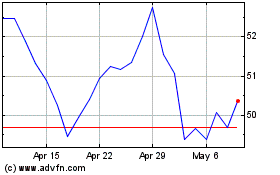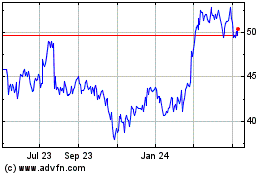By Mark DeCambre and Victor Reklaitis, MarketWatch
Yield for the 30-year Treasury bond hits 3%, marks highest level
since May
U.S. stock indexes ended mostly lower on Thursday, switching
between gains and losses as fears of a pick up in inflation and
rising bond yields fostered emerging volatility on Wall Street.
What are the main benchmarks doing?
The Dow Jones Industrial Average rose 37.32 points, or 0.1%, to
finish at 26,186.71, well off its session low at 26,014, when it
tumbled by 135 points. Dow components Goldman Sachs Group Inc. (GS)
and JPMorgan Chase & Co. (JPM) led gains, as the businesses of
financial firms tend to benefit in a rising rate environment.
Meanwhile, the S&P 500 index slipped 1.83 points, or about
0.1%, to end at 2,821.98, with the consumer-discretionary,
materials helping to lead declines, while shares of bond
proxies--utilities and real estate--all finished at least 1.4%
lower.
The Nasdaq Composite Index , meanwhile, saw the steepest slide,
finishing off 25.62 points, or 0.4%, at 7,385.86.
Thursday's trading action puts the Dow on track to register its
biggest weekly fall since Sept. 9. 2016, the S&P 500 is on pace
for its steepest weekly slump since Nov. 4, 2016, while the Nasdaq
Composite is on pace for its worst such trading stretch since
June.
On Wednesday, the Dow rose by 72.50 points, or 0.3%
(http://www.marketwatch.com/story/dow-set-to-stabilize-after-shedding-540-points-in-2-days-2018-01-31),
while the S&P and Nasdaq Composite inched higher. The moves
came as the Federal Reserve kept a key interest rate steady but
signaled it is on course to hike rates
(http://www.marketwatch.com/story/fed-takes-step-toward-rate-hike-as-baton-set-to-pass-to-powell-2018-01-31)
at its meeting next month.
Check out:Here's how the Dow, S&P 500 tend to perform after
a rip-roaring January
(http://www.marketwatch.com/story/heres-how-the-dow-sp-500-tend-to-perform-after-a-rip-roaring-january-2018-01-31)
What are driving markets?
Market participants say fears of resurgent inflation, which has
been sluggish and hanging below the Federal Reserve's 2% annual
target, are beginning to resurface and rattle investors. Signs of
tightness in the labor market implies that wage growth, and prices,
might pick up sooner than Wall Street has been expecting,
compelling the Fed to accelerate its pace of interest-rate
hikes.
Underlining the yield climb for bonds
(http://www.marketwatch.com/story/10-year-treasury-yield-hits-275-for-first-time-in-three-years-2018-02-01),
the rate of the 30-year Treasury bond touched 3% on Thursday,
marking its highest level since May as the 10-year Treasury note
yield climbed to 2.78%, marking a fresh three-year high.
Against that backdrop, Friday's job report will be closely pored
over to determine if a tightening labor market translates to higher
wages.
What are strategists saying?
"The market doesn't seem to know which way it wants to go right
now," said Randy Frederick, vice president for trading and
derivatives at the Schwab Center for Financial Research.
"Labor shortages all of sudden could mean that inflationary
pressures are showing their teeth," he said. Rising inflation is
bad for bonds because it undercuts a bond's fixed value and can
lead to selling, pushing yields higher. Bond prices move inversely
to yields.
"And we are already seeing yields rise and obviously that
creates problems for equities and that could potentially stifle
earnings," he said.
Robert Pavlik, chief investment strategist at SlateStone Wealth
LLC, said reflationary fears may be causing concerns.
"I think the market has been sniffing around for something to
get concerned about and I think that the more directionless trade
is the more you worry about inflation," he said.
"The Federal Reserve has given us a clear message that, barring
some sort of collapse in sentiment over the next few weeks, March
is good to go to lift the fed-funds rate," said Chris Weston, chief
market strategist at IG.
"The narrative perhaps even throws weight to the camp that we
would see hikes in the August, September and December meetings,
too," he said in a note.
What data are in focus?
The number of people who applied for unemployment benefits in
late January fell by 1,000 to 230,000
(http://www.marketwatch.com/story/jobless-claims-fall-slightly-to-230000-layoffs-extremely-low-2018-02-01),
keeping initial U.S. jobless claims near a 45-year low. Economists
polled by MarketWatch had forecast a 240,000 reading in the seven
days ended Jan. 27.
Meanwhile, the productivity of U.S. firms and workers fell
(http://www.marketwatch.com/story/us-productivity-dips-01-in-fourth-quarter-ends-2017-on-sour-note-2018-02-01)
at a 0.1% annual pace in the fourth quarter. Economists polled by
MarketWatch forecast a 0.2% gain.
The Institute for Supply Management
(https://www.instituteforsupplymanagement.org/ISMReport/MfgROB.cfm?navItemNumber=31000&SSO=1)said
its manufacturing index in January slipped to 59.1% from 59.3% in
December. Economists polled by MarketWatch expected a reading of
58.6%. The IHS Markit manufacturing reading showed that final U.S.
PMI steady at 55.5 in January from flash estimates.
Separately, the Commerce Department reported a 0.7% rise in
construction spending
(http://www.marketwatch.com/story/construction-spending-climbs-for-fifth-month-to-new-record-2018-02-01)
in December, and a 2.6% advance over the last 12 months. That is
the fifth monthly gain in a row and a record high.
Detroit auto makers on Thursday reported underwhelming U.S. auto
sales in January
(http://www.marketwatch.com/story/car-makers-post-lackluster-us-january-sales-2018-02-01),
signaling car industry volumes will get off to a relatively muted
start even as the broader economy is strong.
Check out:MarketWatch's Economic Calendar
(http://www.marketwatch.com/economy-politics/calendars/economic)
Which stocks look like key movers?
Shares of online auctioneer eBay Inc.(EBAY) rose 14% after
announcing that it plans to take over crucial payments-processing
duties
(http://www.marketwatch.com/story/ebay-breaks-up-with-paypal-again-stock-soars-as-paypal-shares-dive-2018-01-31)
from PayPal Holdings Inc.(PYPL) as it posted quarterly earnings
(http://www.marketwatch.com/story/paypal-stock-falls-after-fourth-quarter-earnings-2018-01-31).
Shares of PayPal were shed 8.1%.
Qorvo Inc.'s stock (QRVO) ended up more than 16% after it
reported quarterly revenue that was better than expected
(https://www.barrons.com/articles/qorvo-stock-already-reflects-weak-apple-results-says-drexel-1517437350).
The company, an Apple supplier, was created by the merger of
TriQuint Semiconductor and RF Micro Devices.
Facebook Inc.'s stock (FB) climbed 3.3% after the social media
giant late Wednesday reported double-digit advertising price growth
(http://www.marketwatch.com/story/facebook-earnings-stock-touches-record-after-massive-ad-price-increase-2018-01-31)
amid massive changes to its core product. Shares initially dropped
as the company's release revealed a decline in usage of its
platform.
Check out:Facebook's 'powerful' ad business means it is time to
buy--analysts react to earnings
(http://www.marketwatch.com/story/facebooks-powerful-ad-business-means-its-time-to-buy-analysts-react-to-earnings-2018-02-01)
Apple Inc. shares (AAPL) closed regular trade up 0.2% as the
tech giant was set to report after the closing bell.
See:The $1,000 iPhone X remains the story as Apple's earnings
arrive
(http://www.marketwatch.com/story/apple-earnings-forget-taxes-and-batteries-the-1000-iphone-x-remains-the-story-2018-01-26)
Microsoft Corp.'s stock (MSFT) finished down 0.8% after the
software heavyweight posted better-than-expected earnings
(http://www.marketwatch.com/story/shares-of-microsoft-slide-as-software-giant-reports-a-quarterly-loss-on-tax-cuts-2018-01-31).
Shares of Hershey Co.(HSY) slid 6% after the confectionery maker
reported fourth-quarter net income of $181.1 million
(http://www.marketwatch.com/story/hershey-earnings-and-sales-miss-consensus-2018-02-01),
or 85 cents per share, up from $116.9 million, or 55 cents per
share, for the same period last year.
First Take:Microsoft earnings show Nadella is blazing the right
path
(http://www.marketwatch.com/story/microsoft-earnings-show-nadella-is-blazing-the-right-path-2018-01-31)
What are other assets doing?
European stocks ended lower
(http://www.marketwatch.com/story/european-stocks-break-3-day-losing-run-after-solid-finance-tech-earnings-2018-02-01),
while Asian markets closed mixed. Gold futures settled modestly
higher
(http://www.marketwatch.com/story/gold-slips-finds-little-traction-in-feds-inflation-view-2018-02-01),
as oil futures scored their biggest one-day gain in more than a
week
(http://www.marketwatch.com/story/oil-resumes-climb-on-us-gasoline-demand-2018-02-01-81031226).
The ICE U.S. Dollar Index weakened for a third straight session
(http://www.marketwatch.com/story/dollar-falls-for-3rd-day-as-traders-shake-off-hawkish-fed-signals-2018-02-01).
(END) Dow Jones Newswires
February 01, 2018 16:47 ET (21:47 GMT)
Copyright (c) 2018 Dow Jones & Company, Inc.
eBay (NASDAQ:EBAY)
Historical Stock Chart
From Mar 2024 to Apr 2024

eBay (NASDAQ:EBAY)
Historical Stock Chart
From Apr 2023 to Apr 2024
